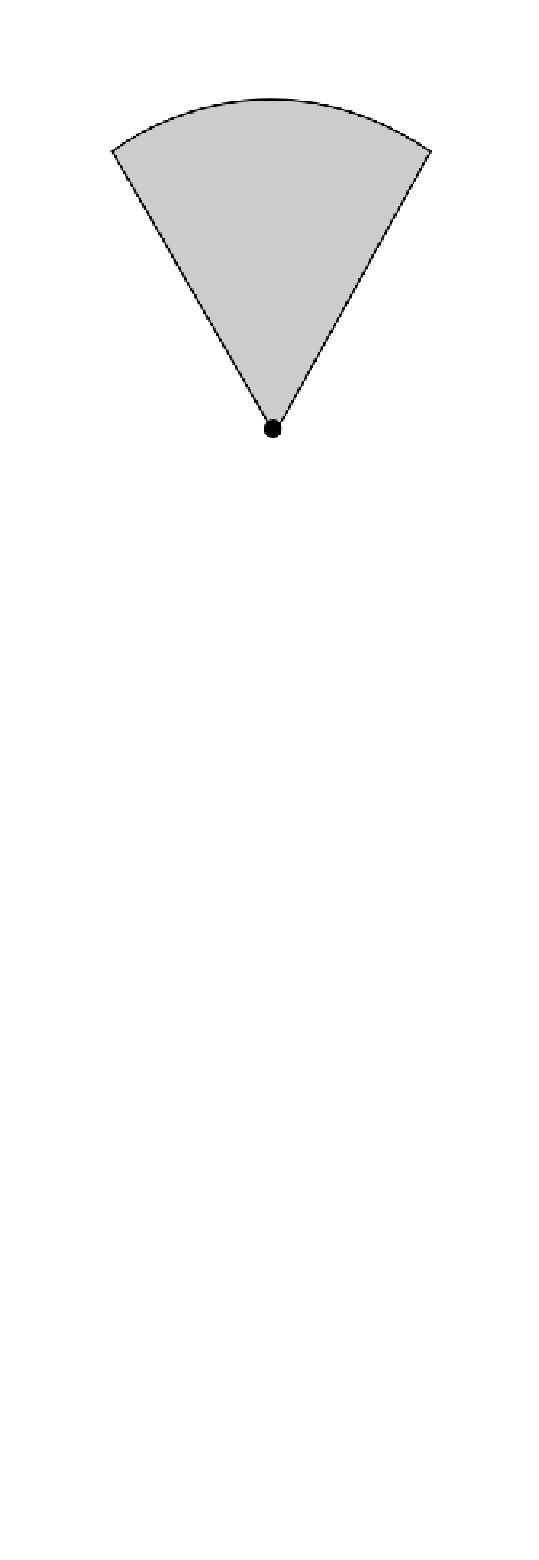Geoscience Reference
In-Depth Information
3.8.1 A mythological thought experiment to illustrate
relative angular motion
Apparent displacement of
p
1
at latitude,
,
during passage in time,
t
, of Aeolus's wind
=
ut
(
Ω
sin
u
t
) = (
Ω
sin
u
)
ut
2
u
Final
target
position
Initial
target
position
King Aeolus governed the planetary wind system in Greek
mythology; it was he who gave the bag of winds to
Odysseus. He was ordered by his boss, Zeus, feasting as
usual at headquarters high above Mount Olympus, to beat
up a strong storm wind to punish a naughty minor god-
dess who had fled far to the East in modern day India.
Aeolus, who was in Egypt close to the equator at the time
observing a midsummer solstice, climbed the nearest
mountain and pointed his wind-maker exactly East to
release a great long wind that eventually reached and laid
waste to the goddess's encampment by the River Indus.
Zeus was pleased with the result and rewarded Aeolus with
plenty of ambrosia. Some months later another naughty
goddess fled north from Olympus in the direction of the
frozen wastes of Scythia, for some reason (modern day
Russia). Zeus again instructed Aeolus, now home from his
Egyptian expedition, to let loose the punishing wind.
Aeolus ascended Olympus, pointed his wind-makers
exactly North and released another great long wind.
However, this time, from his vantage point in the clouds
above Olympus, Zeus sees the wind miss his target by a
considerable margin, devastating a large area of forest well
to the East. This happens over and over again. Zeus is
highly displeased and calls an inquest into the sorry state of
Aeolus's intercontinental wind punisher, vowing after the
inquest to use Poseidon's earthquakes for the purpose in
future.
Arc defining
motion as seen
by observer
moving with
surface from
p
1
to
p
2
p
2
p
1
r
r
line defining:
(1) distance,
r = ut
(2) aim from
blowing position
(3) path seen
from space
Ω
Blowing position wind speed =
u
Fig. 3.33
The short-lived Aeolus wind-punisher.
(Fig. 3.33). However, to the terrified Scythians looking
South the incoming wind seemed to them to be affected
by a mysterious force moving it progressively to their left,
that is, eastward, as it traveled northward.
We draw the following conclusions:
1
On a rotating sphere, fixed observers see radial deflections
of moving bodies largely free from frictional constraints. Such
deflections involve radial acceleration and a force must be
responsible.
2
The magnitude of the deflection and the acceleration
increases with increasing latitude.
3
The deflection
with respect to the direction of flow
is to
the right in the Northern Hemisphere and to the left in
the Southern.
4
To observers outside the rotating frame of reference
(i.e. Gods) no deflection is visible.
5
For zonal motion at the equator there is no deflection.
3.8.2 The Aeolus postmortem: A logical
conceptual analysis
Earth spins rapidly upon its axis of rotation; in other words
it has vorticity. It has an angular velocity,
, of
7.292
10
5
rads
1
about its spin axis that decreases
equatorward as the sine of the angle of latitude. It also has
a linear velocity at the equator of about 463 ms
1
; this
decreases poleward in proportion to the cosine of latitude.
Any large, slow-moving object (i.e. slow-moving with
respect to the Earth's angular speed) not in direct fric-
tional contact with a planetary surface and with a merid-
ional or zonal motion is influenced by planetary rotation:
a curved trajectory results
with respect to Earth-bound
observers
(Fig. 3.33). The exceptions are purely zonal
winds along the equator, by chance the first success of
Aeolus. To Aeolus observing the wind from above
Olympus (i.e. his reference axes were not on the fixed
Earth surface), it seemed to travel in a straight line
3.8.3
Toward a physical explanation; First, shear
vorticity
Streamline curvature in fluid flow signifies the occurrence
of
vorticity
,
(eta) (Section 2.4). Clearly, fluid rotation can
be in any direction and of any magnitude. Like in consid-
erations of angular velocity (Section 2.4), the direction in
question is defined with respect to that of a normal axis to
the plane of rotation, both carefully specified with respect
to three standard reference coordinates. Regarding signs














Search WWH ::

Custom Search